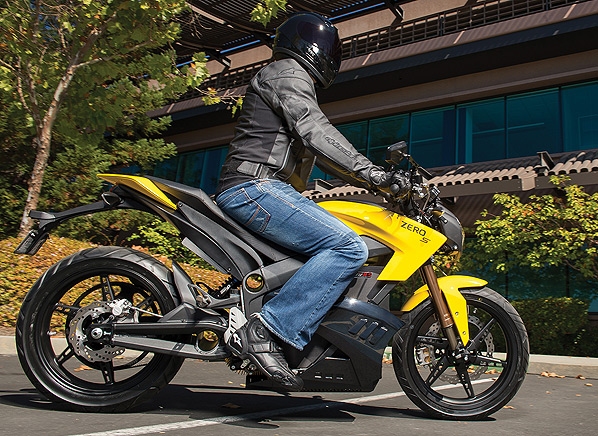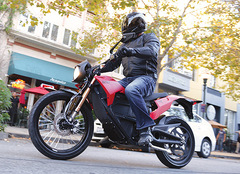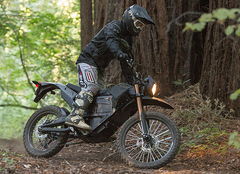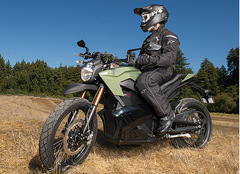
The first time Zero Motorcycles stopped by our headquarters four years ago, we were intrigued by the promise of electric motorcycles, but our team felt they needed more work. Fast forward a few years, and the new line from Zero comes across as mature and well thought out.
Staff riding enthusiasts sampled several motorcycles, including the entry-level XU, Zero S street fighter, Zero DS dual sport, and Zero FX stealth fighter.
As Consumer Reports engineer Marc McEntee put it, "The new models are not evolutionary, but revolutionary. They are real motorcycles with electric motors. They accelerate, brake, and feel like the real thing." Indeed, this impression was shared by the several staffers who rode the bikes.
 In the time since we last met, Zero gathered motorcycle industry veterans to develop three fresh product lines with increased range and performance. About the only thing that looked familiar on their second visit was the Mercedes-Benz Sprinter van carrying the bikes.
In the time since we last met, Zero gathered motorcycle industry veterans to develop three fresh product lines with increased range and performance. About the only thing that looked familiar on their second visit was the Mercedes-Benz Sprinter van carrying the bikes.
The new lineup has all the virtues of those early bikes, but with beefed up components, a powerful new motor, and the appearance of "real" motorcycles. They're still new-rider friendly, with relatively light weight and shiftless electric drive. Being virtually maintenance free remains a real attraction.
Our riders universally commented on the ease of use. With no need to shift, there are fewer controls to operate than with a traditional motorcycle. Simply twist the throttle and go. In "Eco" mode, regenerative braking causes rapid deceleration when the throttle is eased, described by one editor as "touchy," allowing the brakes to capture kinetic energy to replenish the battery. We wish the bikes had antilock brakes, especially as they have unique appeal to less-experienced riders. A company official explained that antilock systems were simply cost prohibitive at the current sales volume of about 1,500 units a year. However, due to coming overseas regulations, Zero plans to have ABS by 2016. (See our guide to the 2013 motorcycles and scooters with ABS.)
The electric powertrain gives the bikes unique appeal. Senior Associate Editor Eric Evarts noted that the Zeroes are "really easy to ride, with effortless and silent acceleration."
Senior Auto Test Engineer Gabe Shenhar said, "I thought I might miss the tingle and sound of a real motorcycle, but the lack of vibration throughout your body is a breath of fresh air."
 Range varies significantly by model, battery set-up, and of course, how you ride. With just one battery, the $7,995 XU has a claimed urban range of 38 miles. Add a second battery and the range extends to 76 miles city. On the highway at 55 mph, Zero claims a 48 mile range. At 70 mph, that drops to 35 miles. This small bike, with a feather-like 260-lb. curb weight, has the unique benefit of removable batteries; this can be a boon for city dwellers that may want to tote a battery into an apartment to recharge. Depending on the bike and battery pack, Zero touts that the lithium-ion batteries are engineered to last 87,000 to over 300,000 miles--further than many motorcycle owners may ride in a lifetime.
Range varies significantly by model, battery set-up, and of course, how you ride. With just one battery, the $7,995 XU has a claimed urban range of 38 miles. Add a second battery and the range extends to 76 miles city. On the highway at 55 mph, Zero claims a 48 mile range. At 70 mph, that drops to 35 miles. This small bike, with a feather-like 260-lb. curb weight, has the unique benefit of removable batteries; this can be a boon for city dwellers that may want to tote a battery into an apartment to recharge. Depending on the bike and battery pack, Zero touts that the lithium-ion batteries are engineered to last 87,000 to over 300,000 miles--further than many motorcycle owners may ride in a lifetime.
The 54-hp Zero S street fighter has a much greater range at 70 miles combined for the ZF8.5 ($13,995) and 93 miles combined with the larger pack in the ZF11.4 ($15,995). Stick to the city and the ZF11.4 can go 137 miles--or a multiple of what the average American drives daily. (The model designations take their names from the battery capacity, in this case 11.4 kWh.) Zero estimates that the cost to recharge the ZF11.4 is a mere $1.20. The team enjoyed this electric sport bike, zipping up and down the local parkway, and savoring its thrilling, effortless near-silent acceleration.
Tester Rich Handel was captivated by the 275-lb. FX. Dubbed a "stealth fighter," this bantam-weight electric is a nimble dual-purpose bike derived from the MX off-road platform. Handel commented, "The FX really wowed me. The torque off the line is amazing. I took it on a trail, and it felt great. I surprised a deer along the way because of the bike's stealth and then the deer ran alongside of me for a bit." Talk about communing with nature... The FX ($11,990) has 44 hp and 70 lb.-ft. of torque, making it quite responsive and entertaining.
 Fellow trail rider McEntree later noted the virtues of being able to explore the wilderness without disturbing it or the neighbors. His Zen-like take was that by running silent, you can better experience the environment without affecting it.
Fellow trail rider McEntree later noted the virtues of being able to explore the wilderness without disturbing it or the neighbors. His Zen-like take was that by running silent, you can better experience the environment without affecting it.
Our tallest rider favored the Zero DS, a larger all-terrain motorcycle. Weighing in at 395 lbs., the DS boasts 54 hp and provides ample power. However, at $16,000, its price is steep and the finish isn't up to conventional competitors priced thousands less.
Bottom line:
Zero has come a long way, and they are blazing a trail to a convenient, gas-free future. Some staffers described the company as the "Tesla of the motorcycle world." They are a true game changer. However, conventional competition can often be found for two-thirds or half the price.
Where we think Zero stands out is not just in the inexpensive operating costs, but in the convenience of hop on and go. No worries about tuning carbs or tending to inconvenient maintenance rather than taking a recreational ride. Plus, there is significant appeal for new riders, or those facing congested city streets. (To see what goes wrong on motorcycles, read the results of our motorcycle reliability survey.")
Priced from $7,995 to $15,995, Zero Motorcycles are not cheap. But their ease of use, minimal maintenance needs and costs, and available federal and state tax incentives, give these electric bikes distinct appeal.
Learn more about riding in our motorcycle hub, buying guide, and in our reliability and owner satisfaction report.





